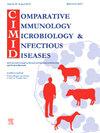犬血头绦虫和鸭透明瘤犬肝虫病的分子流行率和遗传多样性
IF 2
3区 农林科学
Q4 IMMUNOLOGY
Comparative Immunology Microbiology and Infectious Diseases
Pub Date : 2025-04-14
DOI:10.1016/j.cimid.2025.102338
引用次数: 0
摘要
犬肝虫是一种顶端复合体原生动物寄生虫,可通过属鼻头虫属和无肢虫属的硬蜱传播给犬科动物。由于户外活动和与环境的接近,狗更容易接触到病媒和病媒传播的疾病。本研究旨在报道巴基斯坦两省感染犬只的猪肝虫( = 88)和猪透明瘤( = 16)DNA中犬肝虫的分子流行情况。还确定了寄生虫的遗传多样性和与感染相关的危险因素。收集104蜱虫从六个地区:德拉拉什德汗(47 %),上层Dir (n = 10),斯瓦特(n = 10),布内尔(n = 13),白沙瓦(n = 13)和科哈特(n = 11)。总的来说,PCR扩增出来自肝虫犬18S rRNA基因的460-520碱基对扩增子,在筛选的104只蜱中有18只(17% %)扩增出。其中,猪眼透明瘤感染19. %,血根头绦虫感染17. %。随后的Sanger测序和BLAST分析证实了寄生虫的存在。犬肝虫病的流行并不局限于特定蜱种或其性别、喂养或发育阶段。寄主犬品种之间的寄生虫流行率也无显著差异。总之,我们报告在巴基斯坦两个省的狗身上发现了血鼻头虫和安纳托利克透明瘤,证实了这种寄生虫感染的地方性。本研究将补充有关巴基斯坦硬蜱中犬肝虫病流行情况的现有信息,并将有助于巴基斯坦犬媒介传播疾病控制的规划和实施。本文章由计算机程序翻译,如有差异,请以英文原文为准。
Molecular prevalence and genetic diversity of Hepatozoon canis in Rhipicephalus sanguineus s.l. and Hyalomma anatolicum infesting dogs
Hepatozoon canis is an apicomplexan protozoan parasite that is transmitted to canids and by hard ticks belonging to Rhipicephalus and Amblyomma genera. Dogs are more exposed to the vectors and vector borne diseases due to their outdoor activities and closer proximity to the environment they are more exposed to the environment. The present study was aimed to report the molecular prevalence of Hepatozoon canis in the DNA of Rhipicephalus sanguineus s.l. (n = 88) and Hyalomma anatolicum (n = 16) that were infesting dogs in two provinces of Pakistan. Genetic diversity of the parasite and risk factors associated with the infection were also determined. A total of 104 ticks were collected from six districts: Dera Ghazi Khan (47 %), Upper Dir (n = 10), Swat (n = 10), Buner (n = 13), Peshawar (n = 13) and Kohat (n = 11). Overall, PCR amplified a 460–520 base pair amplicon from the 18S rRNA gene of Hepatozoon canis in 18 out of 104 (17 %) screened ticks. Specifically, 19 % of Hyalomma anatolicum and 17 % of Rhipicephalus sanguineus s.l. were infected. Subsequent Sanger sequencing followed by the BLAST analysis confirmed the presence of the parasite. Partial 18S rRNA gene based phylogenetic analysis revealed that sequences generated in this study were genetically diverse and they were clustered with the 18S rRNA gene sequences reported from various animals in Hungry, Iran, Venezuela, Romania, Spain, Italy India, Israel, Taiwan and Czech Republic. Prevalence of Hepatozoon canis was not limited to a particular tick species or their sex, feeding or developmental stages. Parasite prevalence also varied non significantly between the breed of the host dogs. In conclusion, we are reporting the presence of Hepatozoon canis in Rhipicephalus sanguineus s.l. and Hyalomma anatolicum infesting dogs in two provinces of Pakistan confirming the endemic nature of this parasitic infection. This study will add to the existing information regarding Hepatozoon canis prevalence in hard ticks from Pakistan and will assist in planning and implementation of canine vector borne disease control in Pakistan.
求助全文
通过发布文献求助,成功后即可免费获取论文全文。
去求助
来源期刊
CiteScore
4.60
自引率
0.00%
发文量
102
审稿时长
40 days
期刊介绍:
Comparative Immunology, Microbiology & Infectious Diseases aims to respond to the concept of "One Medicine" and to provide a venue for scientific exchange. Based on the concept of "Comparative Medicine" interdisciplinary cooperation between specialists in human and animal medicine is of mutual interest and benefit. Therefore, there is need to combine the respective interest of physicians, veterinarians and other health professionals for comparative studies relevant to either human or animal medicine .
The journal is open to subjects of common interest related to the immunology, immunopathology, microbiology, parasitology and epidemiology of human and animal infectious diseases, especially zoonotic infections, and animal models of human infectious diseases. The role of environmental factors in disease emergence is emphasized. CIMID is mainly focusing on applied veterinary and human medicine rather than on fundamental experimental research.

 求助内容:
求助内容: 应助结果提醒方式:
应助结果提醒方式:


